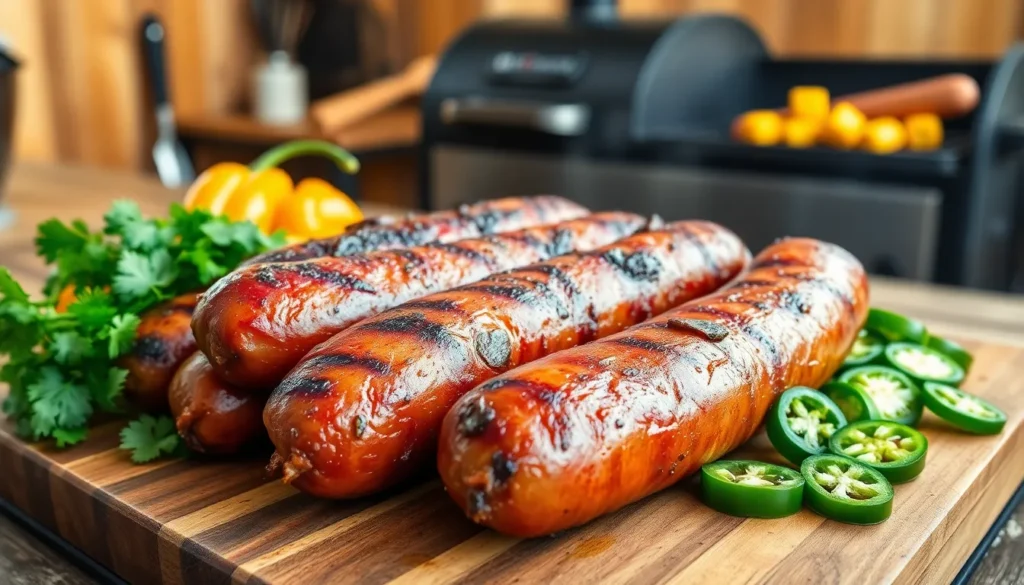Nothing beats the rich, smoky flavor of homemade smoked sausage that fills your kitchen with an irresistible aroma. We’ve perfected this crowd-pleasing recipe that transforms simple ingredients into a mouthwatering delicacy that’ll have your family and friends begging for seconds.
Smoking sausage at home isn’t just about the incredible taste – it’s about creating memorable moments around the dinner table. Our foolproof method delivers perfectly seasoned sausages with that coveted smoky char on the outside and juicy, flavorful meat on the inside.
Whether you’re hosting a backyard barbecue or preparing a hearty weeknight dinner, this smoked sausage recipe guarantees restaurant-quality results every time. We’ll walk you through each step, from selecting the right meat blend to achieving that perfect internal temperature that ensures both safety and maximum flavor.
Ingredients
Creating exceptional homemade smoked sausage starts with selecting premium ingredients that work together to deliver rich flavor and perfect texture. We’ve carefully curated this ingredient list to ensure your sausages achieve that coveted smoky taste and satisfying bite.
For the Sausage Mixture
- 3 pounds ground pork shoulder (80/20 fat ratio)
- 1 pound ground beef chuck (80/20 fat ratio)
- 1/2 cup ice cold water
- 2 tablespoons kosher salt
- 32mm natural hog casings (soaked and rinsed)
- 2 tablespoons olive oil (for brushing)
For the Seasoning Blend
- 2 teaspoons smoked paprika
- 1 teaspoon garlic powder
- 1 teaspoon onion powder
- 1 teaspoon black pepper (freshly ground)
- 1/2 teaspoon cayenne pepper
- 1/2 teaspoon dried thyme
- 1/2 teaspoon mustard seed (ground)
- 1/4 teaspoon coriander (ground)
- 1/4 teaspoon nutmeg (freshly grated)
- 2 tablespoons brown sugar
- 1 teaspoon liquid smoke
Equipment Needed
- Meat grinder or food processor
- Sausage stuffer or funnel attachment
- Digital meat thermometer
- Smoker or grill with smoking capability
- Large mixing bowl
- Sharp knife
- Cutting board
- Kitchen scale
- Wood chips (hickory or apple)
- Aluminum foil
- Butcher’s twine
Preparation

Now that we have our ingredients and equipment ready, we’ll jump into the hands-on process of creating our smoked sausage. This preparation phase requires attention to detail and proper technique to achieve the best results.
Preparing the Meat
We start with about 8 pounds of pork shoulder as our base meat for maximum flavor and texture. Cut the pork shoulder into manageable pieces that will fit easily through your grinder. Keep the meat cold throughout this process to maintain proper texture during grinding.
Before we begin grinding, we chill all grinder parts in the refrigerator or freezer. This step maintains the meat temperature and prevents the fat from smearing, which could result in a poor texture in our finished sausage.
We also soak 3-4 hog casings in cold water during this time. This preparation softens the casings and makes them pliable for stuffing later in the process.
Mixing the Seasonings
Our seasoning blend creates the signature flavor profile that makes this smoked sausage exceptional. We combine these dry ingredients thoroughly in a large mixing bowl:
- ¾ cup brown sugar
- ¼ cup granulated garlic
- ¼ cup onion powder
- ¼ cup onion flakes
- ¼ cup chile powder (green or red)
- ¼ cup dried thyme
- 2 ½ tablespoons smoked paprika
- 2 ½ tablespoons kosher salt
- 2 ½ tablespoons black pepper
- 1 tablespoon + 1 teaspoon dry mustard
We also prepare our fresh vegetables for added flavor and texture. Mince ½ cup green bell pepper, ½ cup red bell pepper, and 1 tablespoon jalapeño. These vegetables provide moisture and a subtle heat that complements the smoky flavors.
Combining Ingredients
After grinding our pork shoulder, we transfer it to a large mixing bowl. Add the prepared seasoning blend and minced peppers to the ground meat. Mix thoroughly using your hands or a large spoon until the seasonings distribute evenly throughout the meat.
We incorporate ½ cup vegetable oil into the mixture for moisture and binding. This oil helps create a juicy texture and prevents the sausage from drying out during the smoking process.
Once our seasoned meat blend achieves uniform consistency, we stuff it into the soaked casings. Form the stuffed casings into individual links by twisting at regular intervals, creating portions that suit your serving preferences.
Stuffing the Sausages
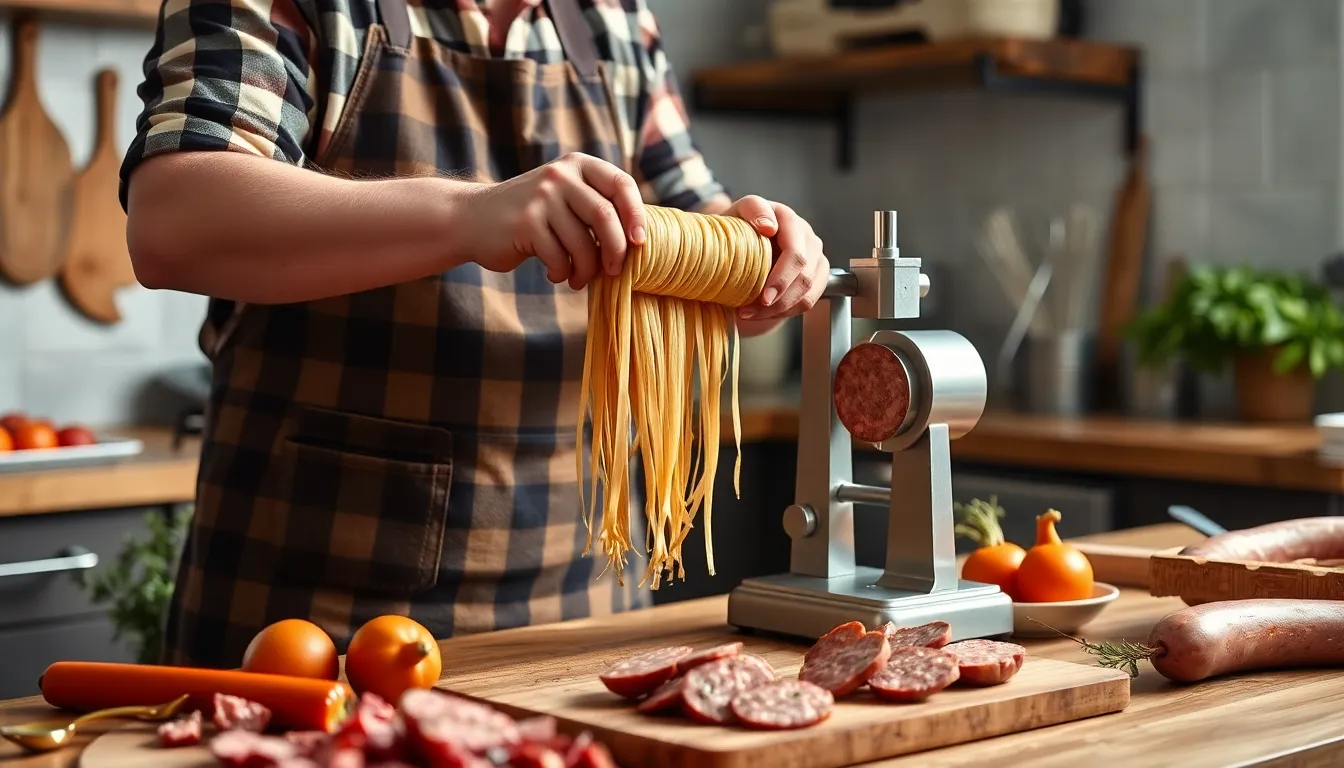
Now that our seasoned meat mixture is ready and chilled, we move to the exciting stage of transforming it into actual sausages. The stuffing process requires careful attention to detail to ensure even filling and proper casing preparation.
Preparing the Casings
We begin by removing our natural hog casings from the cold water where they’ve been soaking. Rinse the inside of each casing thoroughly with cool water to eliminate excess salt and any remaining debris. The casings should feel soft and pliable after their overnight soak. Keep them submerged in fresh cold water until we’re ready to use them, as this maintains their elasticity and prevents tearing during the stuffing process. Slide one end of the casing onto the stuffing tube of our sausage grinder attachment, leaving about 3 inches of loose casing at the end to tie off later.
Filling the Casings
Load our chilled meat mixture into the sausage stuffer, working in batches if necessary. Begin pushing the meat through the grinder slowly and steadily, allowing the mixture to flow into the casing without forcing it. We want to fill the casings tightly but not so much that they burst under pressure. Watch for any air pockets forming in the sausage and gently prick them with a clean needle to release trapped air. The filling should be firm and even throughout the length of the casing. Stop periodically to check that the casing isn’t overstuffed, as this can cause splitting during the cooking process.
Linking the Sausages
Once we’ve filled the entire length of casing, we create individual sausage links by twisting the filled casing at 5 to 6 inch intervals. Start at one end and work our way down the length, making firm twists to separate each link. Alternate the direction of each twist to prevent the links from unraveling later. The first twist should go away from us, the second toward us, and so on down the line. Tie off both ends of the sausage rope securely with kitchen twine. Our linked sausages are now ready for the refrigerator if we’re not smoking them immediately, or we can proceed directly to the smoking stage.
Smoking Instructions
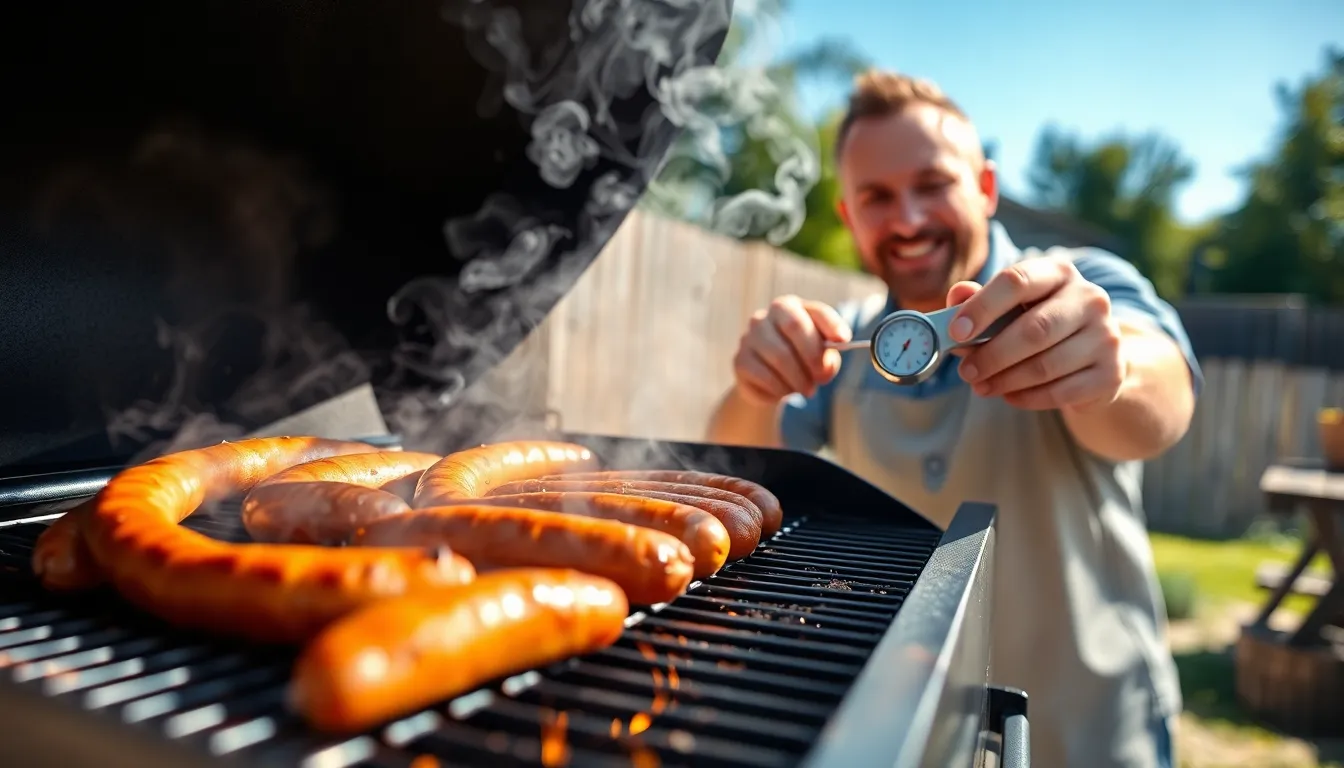
Now that we’ve prepared our sausage links, we’re ready to transform them with the magic of slow smoking. The smoking process requires patience and attention to detail for achieving that perfect balance of smoky flavor and juicy texture.
Setting Up Your Smoker
We begin by selecting the right wood for our smoking needs. Hickory and mesquite deliver strong smoky flavors that complement the rich pork beautifully, while apple or cherry wood provides milder smoke notes for those preferring subtler taste profiles. Our smoker needs preheating to a steady 225°F (107°C) before we introduce the sausages.
Cleanliness plays a crucial role in successful smoking. We ensure our smoker is thoroughly clean and adjust the smoke vent for optimal airflow. Proper ventilation maintains consistent smoke circulation throughout the cooking chamber, preventing bitter flavors from stale smoke buildup.
Temperature and Timing
We smoke our sausages at the consistent temperature of 225°F until they reach an internal temperature between 155°F and 165°F. This low and slow approach typically requires 2 to 3 hours, depending on sausage thickness and smoker performance consistency.
A reliable meat thermometer becomes our best friend during this process. We insert it into the thickest part of several sausages to monitor progress accurately. The target temperature range ensures food safety while preserving the juicy interior texture we desire.
| Smoking Parameter | Specification |
|---|---|
| Smoker Temperature | 225°F (107°C) |
| Target Internal Temperature | 155°F to 165°F |
| Smoking Duration | 2 to 3 hours |
Monitoring the Process
Maintaining consistent temperature requires our active attention throughout the smoking session. We add wood chips or charcoal as needed to keep the heat steady and the smoke flowing. Regular internal temperature checks help us track progress without guesswork.
Restraint becomes important during the smoking process. We resist the urge to open the smoker frequently, as each opening releases heat and smoke, disrupting the cooking environment. Once our sausages reach the target internal temperature, we remove them from the smoker and allow a brief resting period before serving. This rest time helps redistribute juices for optimal texture and intensified flavor.
Cooking Directions
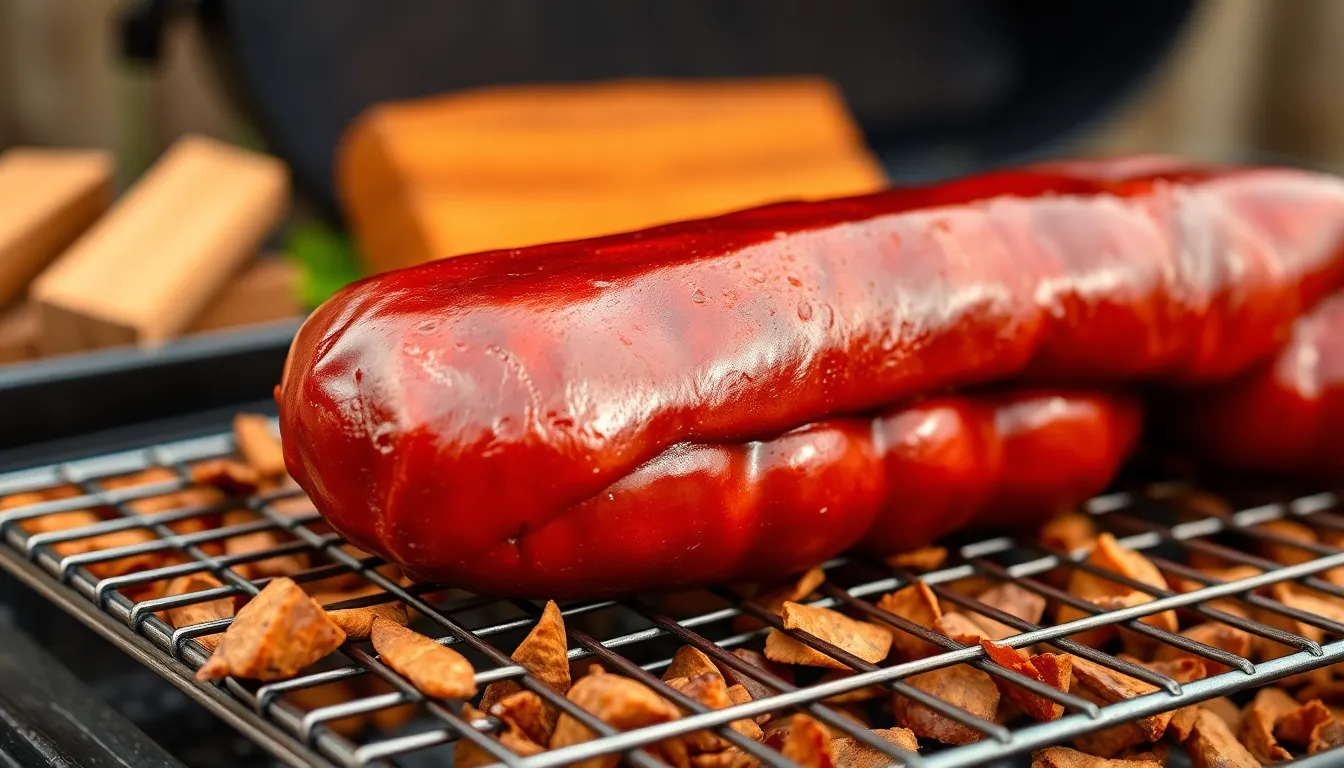
We’ll guide you through two distinct smoking methods that deliver exceptional results. Each technique offers unique advantages for creating perfectly smoked sausages with incredible flavor depth.
Cold Smoking Method
Cold smoking exposes our sausages to smoke at temperatures below 90°F (32°C) without cooking the meat. This method requires prior curing with Prague powder #1 to prevent bacterial growth during the extended smoking process.
We must cure our sausages completely before cold smoking begins. The process takes several hours to multiple days depending on desired smoke intensity. Traditional cold-smoked sausages like salami benefit from this extended exposure to develop complex flavors.
Temperature control remains critical throughout cold smoking. We monitor ambient temperature carefully to stay within the safe range. This method suits experienced sausage makers who understand food safety protocols for cured meats.
Cold-smoked sausages require cooking before consumption. We typically grill or pan-fry these sausages after the smoking process completes.
Hot Smoking Method
Hot smoking cooks our sausages while infusing them with smoky flavor at temperatures between 200-250°F (93-121°C). We preheat our smoker to 250°F before placing the sausage links on the rack.
Cherry or hickory wood provides excellent flavor profiles for our sausages. We smoke the links for 30-40 minutes until the internal temperature reaches 160-165°F (71-74°C) for pork or beef varieties.
| Smoking Temperature | Internal Temperature | Time Required |
|---|---|---|
| 250°F (121°C) | 160-165°F (71-74°C) | 30-40 minutes |
This method simultaneously cooks and flavors our sausages making them ready to eat immediately. We avoid opening the smoker frequently to maintain consistent temperature and smoke circulation.
Finishing Touches
We rest our smoked sausages on a wire rack after removing them from the smoker. This cooling period allows juices to redistribute throughout the meat for optimal texture.
Hot smoked sausages can be grilled or pan-fried briefly to add textural contrast before serving. We slice and serve immediately or refrigerate for later use.
Air bubbles in casings should be pricked before smoking to prevent uneven cooking or bursting. We inspect each sausage link carefully during the smoking process.
Different meat combinations and spice blends allow us to customize flavor profiles. Wood selection also influences the final taste with each variety contributing unique characteristics to our finished sausages.
Storage and Serving

After smoking our homemade sausages to perfection, proper storage and serving techniques ensure we maintain their exceptional flavor and quality. We’ll explore the best methods to preserve our smoky creations and present them beautifully.
Proper Storage Methods
Refrigeration keeps our cooked smoked sausage fresh when stored in an airtight container. We can safely store leftover sausages in the refrigerator for up to 4 days while maintaining their quality and flavor.
Freezing extends storage life significantly when we wrap sausages tightly in plastic wrap before placing them in freezer zip-lock bags. We remove all air from the packaging and label each package before freezing for up to 2 months.
Vacuum packaging offers the most convenient freezing option since we can freeze vacuum-packed sausages as is. This method helps preserve freshness longer than traditional wrapping techniques.
Temperature considerations vary based on our sausage type:
| Sausage Type | Storage Method | Temperature | Duration |
|---|---|---|---|
| Hot smoked/cooked | Refrigerate or freeze | 160°F/72°C internal temp | 4 days refrigerated, 2 months frozen |
| Cold smoked/dry cured | Room temperature possible | Below 59°F/15°C | Extended if humidity <60% |
Hot smoked and cooked sausages require refrigeration or freezing since they retain moisture but reach safe internal temperatures around 160°F (72°C). Cold smoked and dry sausages, particularly salami-type varieties cured with salt and nitrate, can be stored at room temperature when kept below 59°F (15°C) with less than 60% humidity.
Serving Suggestions
Grilled vegetables create the perfect accompaniment to our smoked sausages, adding fresh flavors that complement the smoky richness. We pair sausages with classic condiments like mustard and sauerkraut for traditional German-inspired meals.
Sandwich applications showcase our sausages beautifully when sliced and layered with fresh bread and crisp vegetables. We incorporate them into pasta dishes where their smoky flavor enhances creamy or tomato-based sauces.
Charcuterie presentations highlight our cold sausages when sliced thin and arranged with artisanal cheeses and crackers. We serve warm sausages alongside hearty sides like mashed potatoes, baked beans, or roasted root vegetables for satisfying comfort meals.
Reheating Instructions
Gentle reheating maintains moisture and prevents our sausages from becoming tough or dry. We use several effective methods depending on our time and equipment available.
Pan searing creates attractive browning while warming sausages evenly over medium heat. We lightly brown sliced or whole sausages in a skillet, turning occasionally until heated through.
Oven heating provides consistent results when we wrap sausages in foil and place them in a preheated 325°F (163°C) oven. We heat for 10-15 minutes, checking internal temperature to ensure thorough warming.
Microwave reheating offers quick results when we place sausages on microwave-safe plates and cover loosely. We heat in short intervals while turning regularly to prevent overcooking and maintain even temperature distribution.
We avoid overheating at all costs since excessive heat destroys the delicate texture and smoky flavors we worked so hard to develop during the smoking process.
Tips for Success
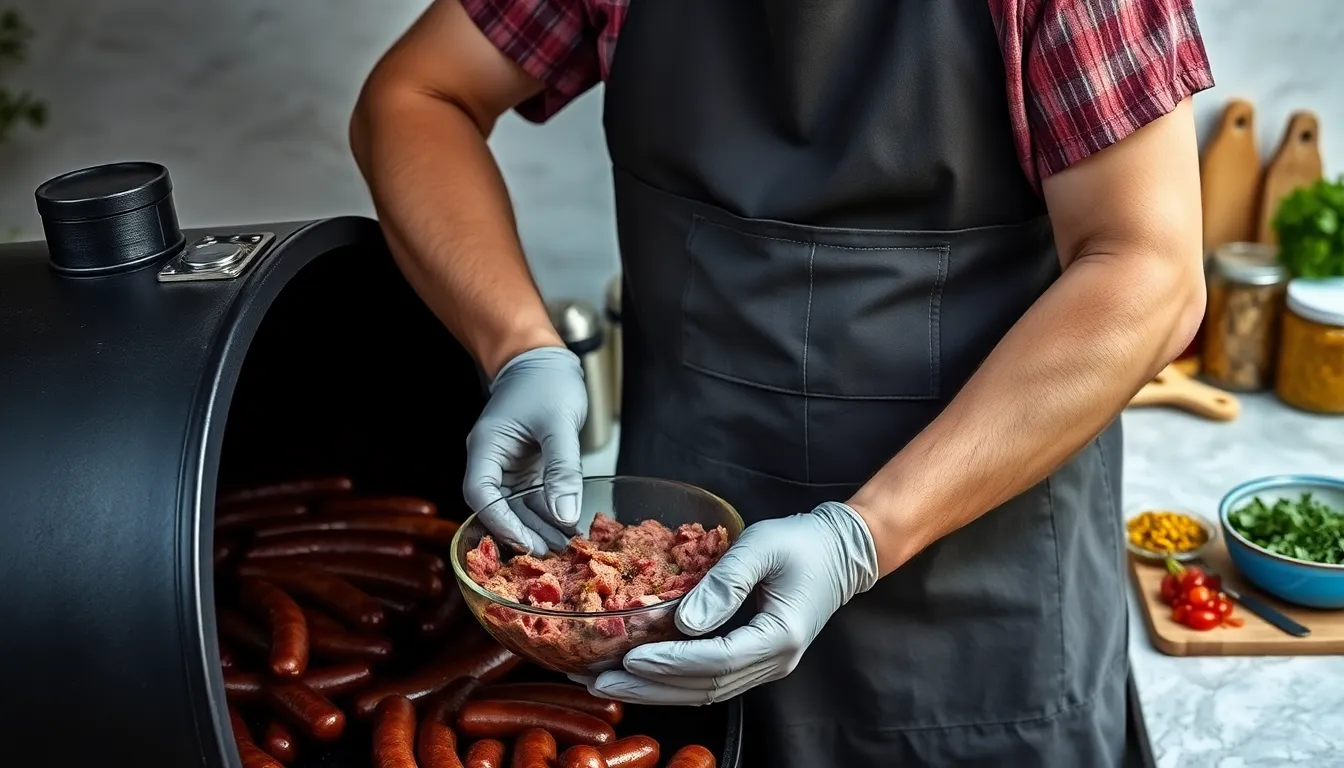
Mastering the art of smoked sausage requires attention to detail and understanding key principles that separate exceptional results from mediocre ones. We’ve gathered essential insights to ensure your sausage-making experience delivers consistently delicious outcomes.
Troubleshooting Common Issues
Dry Sausage Problems
Lean meat selections often lead to disappointingly dry sausages that lack the juicy texture we expect. We recommend using fatty cuts of pork shoulder containing at least 20-30% fat content to maintain moisture throughout the smoking process. Adding vegetable oil to the mixture provides additional moisture retention when working with leaner cuts.
Temperature Control Challenges
High smoking temperatures frequently cause moisture loss and tough textures. Maintain steady temperatures between 200-250°F (93-121°C) for optimal results. We suggest investing in a reliable thermometer to monitor both smoker and internal sausage temperatures consistently.
Sausage Casing Issues
Fresh casings require proper preparation to prevent breakage during stuffing. Soak natural hog casings in cold water for at least 30 minutes before use to ensure pliability. Avoid overstuffing casings as this creates excessive pressure that leads to ruptures during smoking.
Uneven Flavor Distribution
Insufficient mixing creates pockets of underseasoned meat that compromise overall taste. We thoroughly combine all seasonings with the ground meat for at least 2-3 minutes to achieve uniform flavor distribution. Finely minced peppers and spices integrate more effectively than coarsely chopped ingredients.
Smoke Penetration Problems
Inconsistent airflow and temperature fluctuations prevent proper smoke absorption. Maintain steady smoke production throughout the cooking process and avoid opening the smoker frequently as this disrupts the smoking environment.
Flavor Variations
Cheese Enhanced Versions
Cheddar chunks transform ordinary smoked sausage into a rich and indulgent treat. We incorporate 1-2 cups of smoked cheddar cheese cubes into the meat mixture for gooey pockets of flavor that complement the smoky notes perfectly.
Heat Level Adjustments
Spice preferences vary significantly among different palates. Increase jalapeño quantities or add cayenne pepper for those who enjoy intense heat. We recommend starting with smaller amounts and adjusting based on taste preferences during the mixing stage.
Sweet and Smoky Combinations
Brown sugar balances spice without creating overly sweet results. Maple syrup or honey additions create deeper sweetness profiles when combined with smoked paprika. These ingredients work particularly well with hickory or apple wood smoking.
Herb Infused Options
Fresh herbs elevate the flavor complexity beyond traditional spice blends. Rosemary and sage provide aromatic notes that pair beautifully with pork. We add 2-3 tablespoons of fresh herbs per 8 pounds of meat for optimal herb presence without overwhelming the base flavors.
Alternative Meat Blends
Different protein combinations create unique texture and flavor profiles. Mixing pork with beef chuck produces firmer textures while turkey additions create lighter alternatives. We maintain the fat content around 20-25% regardless of the meat combination to ensure proper moisture levels.
Conclusion
We’ve walked you through every step of creating exceptional smoked sausages from scratch. From selecting the perfect meat blend to mastering the smoking process our comprehensive guide ensures you’ll achieve professional-quality results in your own kitchen.
The key to success lies in attention to detail—maintaining proper temperatures keeping ingredients cold and allowing time for flavors to develop. Whether you choose cold smoking for complex flavors or hot smoking for immediate enjoyment both methods deliver outstanding results.
Now it’s time to fire up your smoker and put these techniques into practice. Your homemade smoked sausages will become the centerpiece of countless memorable meals bringing that authentic smoky flavor we all crave to your dining table.
Frequently Asked Questions
What temperature should I smoke homemade sausages at?
Smoke your homemade sausages at a steady 225°F (107°C). This temperature ensures even cooking while allowing the smoke to penetrate the meat properly. The sausages should reach an internal temperature of 155°F to 165°F, which typically takes 2 to 3 hours depending on thickness.
What’s the best wood for smoking sausages?
Hickory and apple wood are excellent choices for smoking sausages. Hickory provides a strong, traditional smoky flavor, while apple wood offers a milder, slightly sweet taste. Both woods complement the rich flavors of pork and beef sausages without overpowering the meat’s natural taste.
How long do homemade smoked sausages last in the refrigerator?
Properly stored homemade smoked sausages last 3-5 days in the refrigerator when kept at 40°F or below. For longer storage, vacuum-sealed sausages can be frozen for up to 6 months. Always store them in airtight containers or wrap them tightly to prevent moisture loss and contamination.
What’s the difference between cold smoking and hot smoking sausages?
Cold smoking exposes sausages to smoke below 90°F without cooking them, requiring prior curing and subsequent cooking before eating. Hot smoking cooks sausages at 200-250°F while infusing smoky flavor, making them ready to eat immediately. Hot smoking is safer and more suitable for beginners.
What meat blend works best for homemade sausages?
A combination of pork shoulder and beef chuck provides the ideal balance of flavor and fat content. Use about 70-80% pork shoulder and 20-30% beef chuck for optimal results. The fat content should be around 20-30% to ensure juicy, flavorful sausages that won’t dry out during smoking.
How do I prevent my sausage casings from bursting?
Avoid overstuffing casings and maintain consistent pressure while filling. Soak natural hog casings in cold water for at least 30 minutes before use to ensure pliability. Check for air pockets and prick them with a needle. Keep casings moist throughout the stuffing process to prevent cracking.
Can I reheat smoked sausages without drying them out?
Yes, use gentle reheating methods to preserve moisture. Pan sear over medium heat for 2-3 minutes per side, reheat in a 350°F oven for 10-15 minutes, or microwave on 50% power in 30-second intervals. Adding a splash of water or beer helps maintain moisture during reheating.
What equipment do I need to make homemade smoked sausages?
Essential equipment includes a meat grinder, sausage stuffer, smoker, and digital thermometer. You’ll also need natural hog casings, kitchen twine, and sharp knives. A scale for accurate measurements and refrigeration space for chilling ingredients are also important for successful sausage making.

